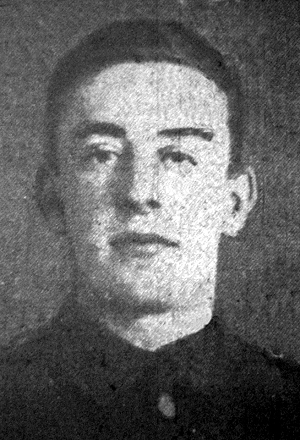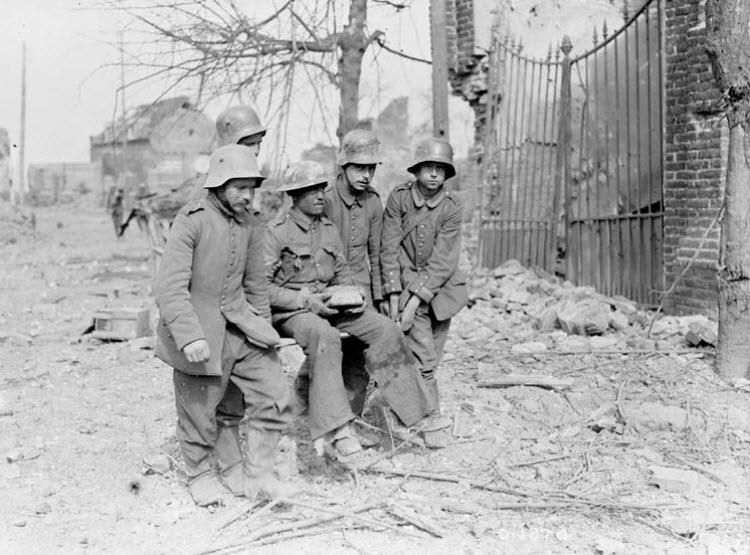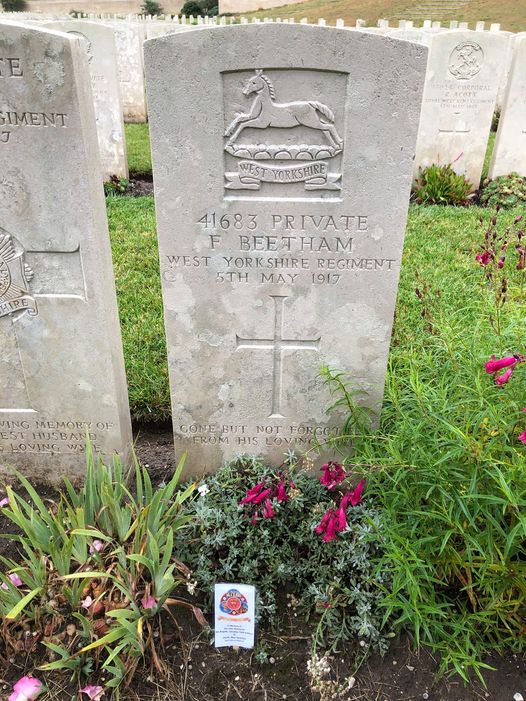
Freddy Beetham was born in Ravensthorpe, Dewsbury in July 1892, the youngest of four children and the only son of Frederick William Hancock Beetham (1854-1904), a rag grinder, born in Leeds and his wife, Ossett born Sarah Elizabeth Wilson (1854-1901). The couple had married in South Ossett Church on the 2nd January 1876, but the grrom’s name on the Banns was shown incorrectly as Beedham.
In 1901, “Freddy” Beetham is living at Sackville Street, Ravensthorpe with his parents. Freddy had three older sisters: Ada, Ethel and Harriet Beetham with the eldest two being born in Ossett. The youngest sister Harriet was born in Stainclffe, Dewsbury, most likely at the maternity hospital.
After the early death of his parents, Fred Beetham was working as a farm labourer in 1911 at Arthur Clegg’s farm on Wesley Street, Ossett, which was where where he also lived.
Fred Beetham married Ada Walker in Ossett in the December quarter of 1913, and the couple were living at 28, Victoria St., Manor Rd., Ossett, Yorks. Their first child Lewis Beetham was also born in late 1913 and a second child, Ernest Beetham was born in late 1914, both in Ossett.
Private Beetham died of wounds on the 5th May 1917 aged 24 years, probably in the build up to the Battle of Arras. No service record exists for his war service.
The “Ossett Observer” 1 had this report of Prviate Beetham’s death: “Private Fred Beetham (25), a well-known Ossett soldier, has died from wounds in a French hospital. Enlisting with the local company of infantry in the early days of the war, Private Beetham, whose home was 20, Little Town-End, Ossett, was afterwards drafted into the West Yorkshire Regiment, and proceeded to the western front five months ago. On Thursday last week, acting upon official information received by telegram, his wife proceeded to France, where she saw her husband in hospital, suffering from the effects of serious wounds in the leg. He died on Saturday. Before the war he was employed by Mr. W. Binks, hay and corn merchant.”
The 10th West Yorkshire Regiment (The Prince of Wales’s Own) is one of the “forgotten” battalions of the Great War. Its part in the Battle of Arras features little in recent histories and its role in other actions has been also largely overlooked. Formed at York in September 1914, 10/West Yorks had trained at Wareham and was sent to France in July 1915. It saw action in and around the Hooge and Bluff sectors and at Fricourt on the 1st July 1916, suffering enormous casualties on the opening day of the Somme offensive in 1916. Eleven officers and 299 other ranks were killed in total. The actions of 10/West Yorkshire Regiment during the Battle of Arras can be broken down into two phases. These cover the First and Second Battles of the Scarpe between the 9th to the 14th April and the 23rd to the 24th April 1917.
The actions in May constitute a third phase and the start of the 3rd battle of the Scarpe, which began on the 3rd May 1917, the day that Fred Beetham was mortally wounded. On the 3rd May 1917, the British launched another attack near the Scarpe. However, they were not able to make any significant advances and the attack was called off the following day after incurring heavy casualties. This was an unmitigated disaster for the British Army, which suffered nearly 6,000 men killed for little material gain.
10/West Yorks was involved in operations to the south and north of the River Scarpe, with Feuchy, Orange Hill, and Lone Copse to the south of the river, and Fampoux, Roeux, and Greenland Hill to the north all featuring heavily in the fighting during April and May.
The total losses suffered by 10th Battalion, West Yorkshire Regiment between the 9th April and the 16th of May 1917 numbered 107. Five officers were killed in total – four on the same day. The war diaries also record that the “enemy was assisted by his aeroplanes.” The largest loss of life was on the opening day of the Second Battle of the Scarpe on the 23rd April when one officer and thirty-eight other ranks lost their lives. Thirteen ORs are also recorded as “missing” in the period 10th April to the 17th May 1917. Approximately two-thirds of the men and officers have no known grave and are commemorated on the Arras Memorial to the Missing. The role of 10/West Yorkshire Regiment at Arras was largely a supportive one which rotated between the rear and forward support lines and front line trenches when not at rest or employed on working or carrying duties. It formed part of 50 Brigade.2

Above: German prisoners of war carrying a wounded Canadian soldier during the Arras offensive in April/May 1917.
Fred Beetham is buried at Etaples Military Cemetery 3, Pas de Calais, France. During the First World War, the area around Etaples was the scene of immense concentrations of Commonwealth reinforcement camps and hospitals. It was remote from attack, except from aircraft, and accessible by railway from both the northern or the southern battlefields. In 1917, 100,000 troops were camped among the sand dunes and the hospitals, which included eleven general, one stationary, four Red Cross hospitals and a convalescent depot, could deal with 22,000 wounded or sick. The cemetery contains 10,771 Commonwealth burials of the First World War, the earliest dating from May 1915. 35 of these burials are unidentified.

Commonwealth War Graves Commission Headstone (Photograph courtesy of Mark Smith)
References:
1. “Ossett Observer”, 12th May 1917
2. 10/West Yorks at Arras: An Overview of a Forgotten Battalion